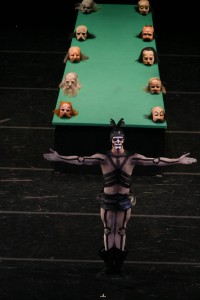This Wednesday, The Joffrey Ballet presents its fall program at The Auditorium Theatre (through Sunday, October 28). Human Landscapes delves into the human spirit with offerings from three distinctively different choreographic voices from three different eras. James Kudelka’s Pretty BALLET was created for the Joffrey dancers in 2010, Jirí Kylián’s Forgotten Land in 1981 and Kurt Jooss’ anti-war ballet, The Green Table, was created in 1932. While the first two show how ballet has grown in the contemporary realm in recent decades, the latter strips ballet down to the bare essentials.
Kudelka has the dancers pushing limits of endurance and questioning the necessary beauty of ballet (much of Pretty BALLET isn’t traditionally pretty), while Kylián challenges dancers to push past safe classical style and to go for moves that are off-center. Jooss uses simple steps and gestures to create strong, human feelings. Artistic Director Ashley Wheater loves the juxtaposition of the three works and says the evening will take you on an emotional journey.
I spoke with Wheater and Jeanette Vondersaar, who is here working with the dancers and setting The Green Table: A Dance of Death in Eight Scenes at Joffrey Tower in late September. Vondersaar was a principal dancer with the Dutch National Ballet in Amsterdam for 21 years and has been restaging The Green Table (originally assisting Jooss’ oldest daughter Anna Markard) since 1995. The Joffrey has included Table in its repertoire since 1967. “I actually saw that performance in ’67 in New York,” said Vondersaar. “I was a trainee with the Harkness School for Ballet Arts. It impressed in my mind, especially the role of ‘Death’. I’ll never forget that.”
What is it about this ballet? Was it something no one had seen before?
AW: It goes back to the danse macabre. You go back culturally to how death…what’s the role it plays in our lives?
JV: It’s inevitable.
AW: It is. It doesn’t matter, you can be the richest person in the world, but we all have to go.
JV: Kurt Jooss was inspired by the medieval dances of death. How he (Death) took those victims from different walks of life and ages. He was fascinated with how he took victims, sometimes violently and sometimes more compassionately. At that time it was between two world wars and he was against the war and what happens after to the people who have suffered from the war. It shows that too. It depicts the whole story.
AW: It was very clear that even though the first World War was over that there was another war looming. And I think if you look at history, there’s always another war.
JV: It’s very relevant. The table scene is the diplomats and the politicians who decide to go to war, but they don’t participate themselves. But at the end, it repeats as if nothing happened, so it’s looming. They don’t learn anything from what happened and a lot of them don’t care.
AW: I would say that The Green Table is such an important piece of work. It has a very clear point of view and it’s not apologetic, yet it’s got so much clarity around it. It’s a very clear statement.
JV: It’s an anti-war statement.
Stylistically, what is different about this ballet?
JV: It’s based on classical ballet. In classical ballet you have a breath or an uplift before a movement and in his movements, they go direct with no preparation. It’s right to the point. The most simple movements…even just the focus of how you look using your eyes. Or your hands and how you open them. If you have your fingers bent, it changes the whole feeling of this openness and this reaching with an open hand an an open heart. This is the kind of thing he developed. It’s so simple and yet so beautiful in its simplicity.
AW: People try to say it’s German Expressionism. I think it’s expressive in that it’s choreographed. He has expressed everything about each character and it’s all done through movement. Movement that’s not complicated. It’s hard to do, but it’s not complicated. There’s no flourish. It is really condensing an emotion to a very straight-forward level.
JV: And within that shows the character.
The Joffrey Ballet presents Human Landscapes at the Auditorium Theatre at Roosevelt University, 50 E. Congress Pkwy., Wednesday, October 17 through Sunday, October 28 (dates and times vary). Tickets are $31 to $152. Call 800.982.2787 or visit ticketmaster.com

